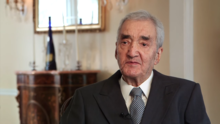Alinaghi Alikhani
Alinaghi Alichani ( Persian علینقی عالیخانی Alinaghi Alichani ; * January 21, 1929 in Chamseh) is an Iranian politician and long-time rector of the University of Tehran . As Iran's Minister of Economic Affairs, Alichani was one of the architects of the economic development of Iran / Persia as part of Shah Mohammad Reza Pahlavi's reform program, which was to go downin Iran's historyas the White Revolution .
Life
Alinaghi Alichani was born on January 21, 1929 in Chamseh, a small town near Abhar. His father managed the royal estates that were located near the city. After the Anglo-Soviet invasion of Iran and Reza Shah's forced resignation by the British , his father gave up his post and ran a small farm in Varamin .
Alinaghi Alichani enrolled in the law faculty of the University of Tehran in 1946 after completing his school education and graduated after three years. He had already been politically active as a schoolboy. Because of his mainly anti-communist political activities against the Tudeh party , he got to know Darius Homayun and Nader Naderpour .
After studying at the University of Tehran, he went to Paris to do a doctorate in economics at the University of Paris. In 1957 he returned to Iran and began his professional career as an economic policy analyst with the newly founded intelligence service SAVAK .
In 1961, Alichani joined the National Iranian Oil Company at the request of Amir Abbas Hoveyda . However, after just a few months, Alichani was appointed Minister of Economics to the government by Prime Minister Asadollah Alam . Alichani remained Minister of Economic Affairs for a total of seven years under Prime Minister Hassan Ali Mansur and Prime Minister Hoveyda.
Alnaghi Alikhani developed and implemented a new economic perspective for Iran, based on the complete transformation of the Iranian economy from a feudal dominated agricultural country into a modern industrial state with a thriving service industry . The plans were based on the decentralization and state funding of the industrial companies initially located in the capital Tehran . State-owned companies were privatized and the establishment of new, private companies was supported by the granting of low-interest loans. In addition to the Iranian market, the newly founded companies should also become internationally competitive with the help of export subsidies .
The success of the new Iranian economic policy was not long in coming. Iranian industry flourished. With the further economic development of Iran, Alichani endeavored to revive economic relations with the Soviet Union in order to create a counterweight to a possible dependence on supplies from the western industrialized countries. In this way he was able to obtain a steel mill, which the USA had refused to deliver to Iran, from the Soviet Union in exchange for natural gas .
After seven years as Minister of Economic Affairs, Alichani resigned in 1969 and became rector of Tehran University. He had drawn up a long list of reforms to adapt Iranian education to the requirements of a modern industrial society using the model of the University of Tehran . First he dismissed over three hundred doctors in the medical school , who called themselves professors, but did not hold any courses. He built a new seminar building for the business faculty and increased funds for the expansion of the library. He also reformed doctoral studies and introduced strict academic supervision for doctoral students. What Alichani had not considered in his reforms aimed at economic efficiency was the changed political situation at the universities. Numerous students sympathized with left-wing guerrilla movements , so that the university campus developed more and more into a political battlefield between left-wing students and the SAVAK .
In 1972 Alinaghi Alichani resigned from his post as rector of Tehran University and went into the private sector. Alichani left Iran in 1979.
literature
- Abbas Milani: Eminent Persians. Vol 1. Syracuse University Press, 2008, pp. 56-62.
| personal data | |
|---|---|
| SURNAME | Alikhani, Alinaghi |
| ALTERNATIVE NAMES | Alichani, Alinaghi; علینقی عالیخانی (Persian) |
| BRIEF DESCRIPTION | Iranian politician |
| DATE OF BIRTH | January 21, 1929 |
| PLACE OF BIRTH | Chamseh |
